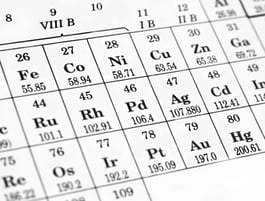 To the disdain of high school chemistry students everywhere, the International Union of Pure and Applied Chemistry recognized four new elements, which completed the seventh row on the periodic table. Earlier this year, the four elements formerly known as atomic numbers 113, 115, 117 and 118 were given names, nihonium (Nh), moscovium (Mc), tennessine (Ts) and oganesson (Og), respectively. The honor of naming the elements was given to the discoverers. A public review of the names expired on November 8, 2015.
To the disdain of high school chemistry students everywhere, the International Union of Pure and Applied Chemistry recognized four new elements, which completed the seventh row on the periodic table. Earlier this year, the four elements formerly known as atomic numbers 113, 115, 117 and 118 were given names, nihonium (Nh), moscovium (Mc), tennessine (Ts) and oganesson (Og), respectively. The honor of naming the elements was given to the discoverers. A public review of the names expired on November 8, 2015.
Among the guidelines given to the discoverers for the elements’ names included the tradition of naming them after a mythological concept or character, a mineral or similar substance, a place or geographical region, a property of the element or a scientist. The names also had to end in "-ium," "-ine," or "-on" depending on the grouping of elements they belong.
“Element 113 is the first to be discovered in an Asian country. The researchers proposed the name nihonium to celebrate it. ‘Nihon’ is one of two ways to say ‘Japan’ in Japanese, and means ‘Land of Rising Sun.’ The element was discovered by a team at RIKEN Nishina Center for Accelerator-Based Science and led by professor Kosuke Morita.” The team bombarded “a thin layer of bismuth with zinc ions traveling at about 10% the speed of light,” which formed an atom of element 113.
Elements 115, 117 and 118 were discovered by a Russian-American team at the Joint Institute for Nuclear Research in Dubna, Russia, and at Oak Ridge National Laboratory in Tennessee and Lawrence Livermore National Laboratory in California
Moscovium and Tennessine honor their place of origin. For Moscovium, “Researchers used the Dubna Gas-Filled Recoil Separator at the Joint Institute for Nuclear Research along with the heavy ion accelerator capabilities at the Flerov Laboratory of Nuclear Reactions in Moscow. For tennessine, researchers at the Oak Ridge National Laboratory, Vanderbilt University and the University of Tennessee at Knoxville worked together on superheavy element research and synthesis using Oak Ridge's High Flux Isotope Reactor and Radiochemical Engineering Development Center.”
Organesson was named for professor Yuri Organessian, a pioneer scientist whose achievements include the discovery of superheavy elements.
Regarding the naming process, IUPAC President Prof. Natalia Tarasova said, “The names of the new elements reflect the realities of our present time, universality of science, honoring places from three continents, where the elements have been discovered -- Japan, Russia, the United States -- and the pivotal role of human capital in the development of science, honoring an outstanding scientist -- Professor Yuri Oganessian.
Unfortunately for chemistry students, researchers are already working on elements that will complete the eighth row.
It didn’t take long for someone to put the new periodic table to song:
https://www.youtube.com/embed/UzvjB5hC2qc
For more information on Elemental analysis and instruments used in various analysis, please visit www.teledyneleemanlabs.com or contact us

